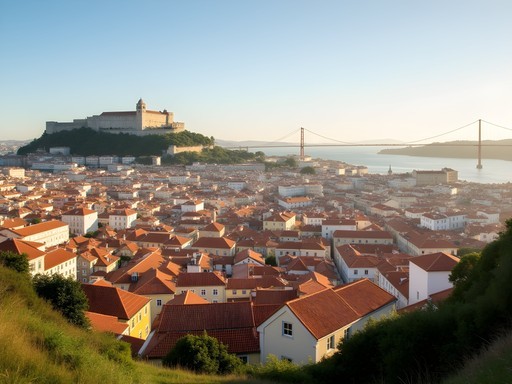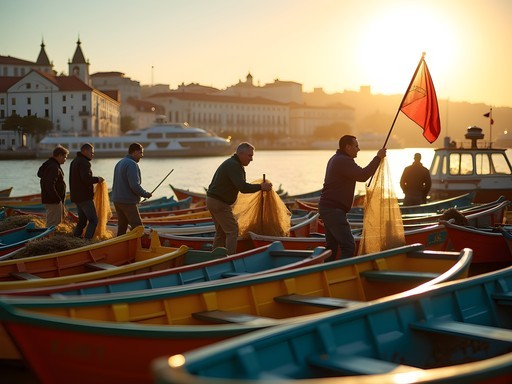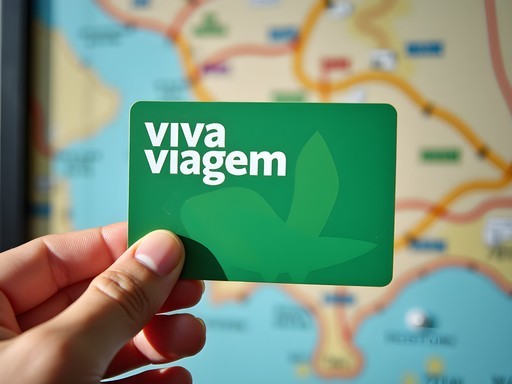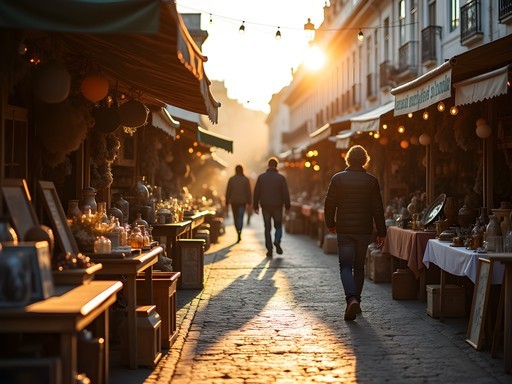Disclosure: This article contains affiliate links. We may earn a commission from purchases at no extra cost to you, which helps our travel content.
The first time I stepped onto Lisbon's iconic yellow Tram 28, I wasn't just boarding public transportation—I was climbing into a living museum. As an educator who's spent decades encouraging children to see learning opportunities everywhere, I found myself becoming the wide-eyed student again. Lisbon isn't just a city you visit; it's a place you navigate through layers of history, culture, and elevation. The Portuguese capital's unique topography—spread across seven steep hills—has necessitated one of Europe's most charming transportation networks. From century-old trams that rattle through narrow alleyways to hidden elevators that connect neighborhoods, the city's transit system isn't merely functional—it's an essential part of experiencing authentic Lisbon. After multiple visits spanning every season, I've compiled this guide to help fellow travelers (especially my educator friends with limited vacation time) unlock the secrets of navigating this magnificent city like a local, without breaking the bank.
Understanding Lisbon's Unique Geography
Before diving into transportation options, it's crucial to understand why Lisbon's transit system evolved as it did. Built across seven steep hills (like Rome, though locals will proudly tell you Lisbon's hills have more character), the city presents a beautiful but physically demanding landscape. My first visit, I stubbornly attempted to walk everywhere—a rookie mistake that left my calves burning by midday.
Lisbon's neighborhoods are distinct microcosms, each with their own personality. Baixa forms the flat downtown core, while Alfama, Bairro Alto, and Graça rise dramatically on surrounding hillsides. The elevation changes aren't subtle—you'll encounter staircases that seem to climb endlessly and streets with inclines that would make San Francisco jealous.
This topography created the need for Lisbon's iconic transportation solutions. What's fascinating from an educational perspective is how these practical necessities evolved into cultural landmarks. The yellow trams, initially introduced in the 1870s as simple horse-drawn carriages, became electric in the early 1900s, and now represent one of the city's most photographed symbols. Similarly, the funiculars and elevators weren't built as tourist attractions but as essential services for residents navigating daily life.
During my classroom video calls connecting my Corpus Christi students with children in Lisbon, my Portuguese teaching colleagues would often point their cameras out school windows to show passing trams—eliciting delighted gasps from my students. These aren't just transportation methods; they're living threads in the fabric of Lisbon's identity.

💡 Pro Tips
- Download the offline map of Lisbon on Google Maps before your trip to understand the city's topography
- When booking accommodation, check the elevation and proximity to public transport stops
- Consider staying in Baixa for your first visit if mobility is a concern—it's the flattest area
Mastering the Iconic Tram System
Lisbon's trams aren't just transportation—they're time machines. The most famous, Tram 28, has achieved near-mythical status among visitors, and for good reason. This vintage yellow carriage winds through the city's most historic neighborhoods, offering an unparalleled sightseeing experience for just a few euros.
However, as an experienced traveler who's ridden Tram 28 during various seasons and times of day, I've developed strategies to enjoy this experience without the frustrations many tourists encounter. The key? Timing and direction.
Most guidebooks suggest boarding at Martim Moniz, the starting point. This is precisely why you shouldn't start there—the queues can stretch for blocks, especially during summer months. Instead, I recommend walking uphill to Campo Ourique or Estrela and boarding in the opposite direction. One April morning, I started at Estrela at 8:30 AM and had my choice of window seats, while watching the tram fill to capacity at later stops.
Beyond the famous 28, Lisbon offers other tram lines worth exploring. Tram 24 provides a less crowded alternative with equally charming views, while Tram 15 connects downtown to Belém, home of the famous pastries and monuments.
For managing your rides, I highly recommend the Lisbon Card, which includes unlimited public transportation plus museum entries. During my last four-day visit, this card paid for itself by the second day, between tram rides and cultural sites.
A word of caution from personal experience: tram pickpocketing is unfortunately common. I use a crossbody anti-theft bag that sits flat against my chest rather than at my side. After witnessing an attempted theft on my second visit, I've become vigilant about this simple precaution.

💡 Pro Tips
- Ride Tram 28 early morning (before 9 AM) or evening (after 7 PM) to avoid the worst crowds
- Board at end-of-line stops like Campo Ourique or Graça rather than Martim Moniz
- Keep your Lisboa Card or ticket easily accessible as inspectors frequently check fares
Funiculars and Elevators: Lisbon's Vertical Transport
While trams navigate Lisbon horizontally, the city's funiculars and elevators tackle its vertical challenges. These ingenious solutions, some dating back to the 19th century, offer both practical transportation and unique experiences that connect Lisbon's upper and lower neighborhoods.
The three historic funiculars—Glória, Bica, and Lavra—each serve different hillsides. Glória, my personal favorite, connects downtown Restauradores Square with the Bairro Alto district. During my first visit, I mistakenly walked up this steep incline, only to discover the funicular on my descent. Learn from my mistake! The Bica funicular offers the most Instagram-famous views, climbing a picturesque street that's appeared in countless photographs. Lavra, the oldest and least touristic, provides a more authentic experience.
Beyond these cable-pulled vehicles, Lisbon offers several public elevators. The most famous is the Santa Justa Lift, an industrial-age masterpiece designed by a student of Gustave Eiffel. While beautiful, its popularity means long queues. Here's my educator's hack: instead of waiting in line to ride up, access the upper platform from Largo do Carmo when visiting the Carmo Convent ruins. You'll enjoy the same panoramic views without the wait.
Less known but equally useful are the municipal elevators hidden throughout the city. These modern conveniences connect neighborhoods at different elevations. During a walking tour with local teachers, I discovered the Município elevator near Rua da Alfândega, which saved us a steep climb while connecting to São Jorge Castle.
For planning these vertical journeys, I rely on a pocket-sized Lisbon travel guide that includes detailed maps showing these connections. The small investment saves hours of unnecessary climbing and helps identify hidden shortcuts between neighborhoods.

💡 Pro Tips
- The Lisboa Card covers all funiculars and the Santa Justa elevator
- Visit the Santa Justa elevator platform from Largo do Carmo to avoid the long ground-floor queues
- Use Google Maps' 'walking' directions in Lisbon—it often suggests elevators and funiculars as part of the route
Hidden Passages and Secret Shortcuts
Beyond the well-documented public transportation options, Lisbon reveals its true character through a network of hidden passages, pedestrian elevators, and local shortcuts that few tourists discover. As an educator who values experiential learning, uncovering these secret pathways has become something of an obsession during my visits.
My introduction to Lisbon's hidden passages came during my second visit, when a local bookstore owner in Chiado drew a series of lines on my map, revealing shortcuts between neighborhoods that saved both time and energy. What appeared on maps as separate streets divided by imposing topography were actually connected by concealed staircases, tunnels, and passageways.
The most fascinating discovery was the network of public elevators and escalators integrated into buildings and streets. Near Baixa-Chiado metro station, a series of escalators inside the Pingo Doce supermarket provides free passage between Baixa and Chiado neighborhoods—a vertical climb that would otherwise require significant exertion. Similarly, the elevator inside the MUDE design museum (currently closed for renovation) connected the lower city with Rua Augusta.
Perhaps my favorite hidden passage connects the Mouraria neighborhood with Praça Martim Moniz through a series of covered walkways dating back centuries. I stumbled upon this route during a sudden rainstorm and found myself walking through living history—passages that have served residents for generations but rarely appear in guidebooks.
For fellow bookstore enthusiasts, the passage through Bertrand Bookstore (the world's oldest operating bookshop) provides not only a shortcut between streets but a literary journey through Portuguese culture. During my visit, I found a bilingual poetry collection that now serves as teaching material for my students back in Corpus Christi.
To discover these passages, I recommend carrying a pocket notebook dedicated to mapping these discoveries. Mine has become a prized possession, filled with hand-drawn maps and notes from locals about their favorite shortcuts.

💡 Pro Tips
- Ask local shopkeepers about shortcuts—they often know time-saving routes between neighborhoods
- Look for public building elevators marked with 'Acesso Público' signs
- The Ascensor do Lavra connects Restauradores to Torel Garden through a hidden passage many tourists miss
Navigating Like a Local: Metro, Buses and Ferries
While Lisbon's charming vintage transportation gets all the attention, the modern metro system, extensive bus network, and Tagus River ferries form the backbone of daily transportation for locals. Understanding these systems transforms your experience from tourist to temporary resident.
Lisbon's metro is clean, efficient, and surprisingly artistic. Each station features unique art installations, effectively creating an underground museum network. During my third visit, I dedicated an afternoon to "metro station hopping," discovering remarkable tile work at Olaias station and contemporary installations at Oriente. The four color-coded lines connect most major areas of interest, though notably miss some historic neighborhoods like Alfama.
The bus system fills these gaps, with routes reaching areas the metro doesn't serve. Bus 737 has become my go-to for reaching São Jorge Castle without the uphill trek, while the 714 connects to areas west of the center. For late-night returns after enjoying Fado performances in Alfama, the night buses (marked with "N") have saved me expensive taxi fares numerous times.
Perhaps the most underappreciated component of Lisbon's transportation network is its ferry system. These boats crossing the Tagus River not only provide essential connections to communities on the southern shore but offer spectacular views of the city skyline. My favorite teaching moment happened on the Cacilhas ferry when a Portuguese grandmother explained to me how the changing light on the April 25th Bridge tells locals about upcoming weather patterns—wisdom I've since shared with my students during our virtual cultural exchanges.
To navigate all these options seamlessly, I rely on the Citymapper app which integrates all transportation methods into one interface. While Google Maps works adequately, Citymapper includes real-time updates specific to Lisbon's network and has saved me countless times when plans changed or services were disrupted.
For a weekend visit, the 24-hour or 72-hour Viva Viagem card offers unlimited travel across all these systems—metro, bus, tram, funicular, elevator, and ferry—providing tremendous value and flexibility.

💡 Pro Tips
- Purchase Viva Viagem cards at any metro station (avoid the tourist-heavy Rossio station where lines are longest)
- Take the Cacilhas ferry for the best sunset views of Lisbon's skyline (costs less than €2)
- Metro stations close at 1 AM, but night buses (marked with 'N') run hourly throughout the night
Final Thoughts
Navigating Lisbon isn't just about getting from point A to B—it's about embracing a transportation network that tells the city's story through movement. As an educator, I've found that Lisbon's trams, funiculars, and hidden passages offer more authentic insights than many museums. They reveal how generations have adapted to challenging topography while preserving cultural heritage. Whether you're climbing aboard the rattling Tram 28 at dawn to avoid crowds, discovering a centuries-old passage between neighborhoods, or crossing the Tagus at sunset for panoramic views, remember that in Lisbon, the journey truly is the destination. I encourage you to put away your rideshare apps for a weekend and embrace these historic transportation methods—not just as practical solutions but as experiences that connect you to the city's soul. Your calves might protest occasionally on those inevitable hills, but your understanding of Lisbon will be infinitely richer for the effort.
✨ Key Takeaways
- Lisbon's transportation system is both practical and an essential cultural experience
- Timing is everything—early morning and evening offer the most authentic experiences on popular routes
- Hidden passages and public elevators provide shortcuts that save energy while revealing local life
📋 Practical Information
Best Time to Visit
year-round, though spring (April-May) and fall (September-October) offer ideal weather with fewer crowds
Budget Estimate
€15-25 per day for transportation using unlimited passes
Recommended Duration
weekend (2-3 days)
Difficulty Level
Beginner
















Comments
waveace
Love this post! Heading to Lisbon in December and definitely saving this for reference. Those yellow trams look so iconic!
wavewanderer9324
Just got back from Lisbon last week and this guide would have been so helpful before my trip! The trams are indeed charming but I found myself using the Metro more than expected - it's super clean and efficient. One thing to note about those hidden passages - they're not always obvious on Google Maps! I discovered a fantastic shortcut from Rossio Square up toward Bairro Alto completely by accident. Also worth mentioning that comfortable walking shoes are absolutely essential. Even with all the public transport options, you'll still be doing plenty of walking on those cobblestone streets and hills.
islandblogger
Could you share more details about those hidden passages? I'm visiting Lisbon next month and staying near Alfama. Are there any secret shortcuts in that area that would help navigate the hills?
adventureguide
Not Joshua, but in Alfama look for the passage near São Miguel church that connects to the viewpoint. Saved me so much climbing! Also download an offline map - cell service can be spotty in those narrow streets.
Frank Garcia
Joshua, this is a brilliant breakdown of Lisbon's transit ecosystem. I backpacked through Portugal last month and found the funiculars absolutely essential for navigating those steep hills. The Ascensor da Bica was my favorite - not just functional but incredibly photogenic. I'd add that the Lisboa Card is worth considering for anyone staying 2+ days as it includes unlimited transit plus museum entries. Also, those hidden passages you mentioned near Baixa-Chiado saved me countless times when trying to cut through to Bairro Alto without the uphill climb. I mapped several of these shortcuts in my travel journal which was incredibly helpful for planning routes each morning.
wavewanderer9324
Frank, did you try the Elevador do Lavra? It's less touristy than the others and I found it charming.
Frank Garcia
Yes! Elevador do Lavra was delightfully under-the-radar. Great suggestion for anyone wanting to avoid crowds while still experiencing Lisbon's unique transport.
adventureguide
This post brought back so many memories! I visited Lisbon last summer and the tram system was both charming and confusing at first. Those hidden passages saved my legs on day three when I discovered them. The Elevador de Santa Justa was definitely worth the wait - the views are incredible. One tip I'd add: buy the 24-hour transit pass if you're planning to explore different neighborhoods. It pays for itself after just a few rides and saves the hassle of buying individual tickets.
waveace
Did you find the trams super crowded? I've heard Tram 28 is basically impossible to get on during peak tourist season.
adventureguide
Definitely crowded midday! My hack was to catch it early morning (before 8am) or later evening. The full route takes about an hour and gives you a great tour of the city's hills.
redclimber
Just booked tickets to Lisbon for March! Saving this post for my trip planning.
coolbuddy36
You'll love it! March should be perfect weather too - not too hot for all those hills!
backpackwalker
We did exactly what you suggested and took Tram 28 at 7:30am - totally different experience than when we tried again at midday! The early morning ride was peaceful and we actually got to chat with some locals heading to work. Also found that secret passage near Rossio Square that cuts through to Baixa - saved so much walking time. Great tips!
Fatima Sims
Joshua, this brought back so many memories! Last year, I got completely lost in Alfama and stumbled upon an elderly Portuguese woman who saw my confusion. Despite the language barrier, she guided me through a series of hidden passages I would never have found on my own. We emerged right by a tiny family-run tasca where I had the best bacalhau of my life. That's the magic of Lisbon - the official transport network is just the beginning of the adventure. The real city reveals itself when you get a little lost and follow the locals. For anyone visiting, don't be afraid to put the map away sometimes and just wander!
roamperson
Are the trams super crowded year-round or is there a better season to visit when they're less packed?
Fatima Sims
January and February are definitely the quietest months in Lisbon! I rode Tram 28 at 10am on a Tuesday in February and had a seat all to myself. Magical experience watching the city go by without the summer crowds.
sunnyblogger
Love this guide! The funiculars saved my legs on those hills!
Venture X
Premium card with 2X miles, $300 travel credit, Priority Pass